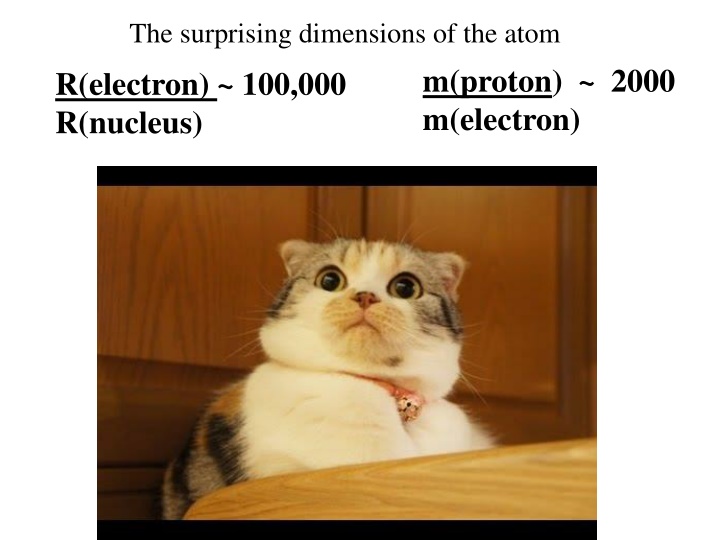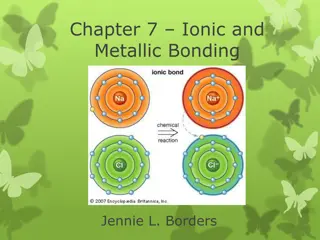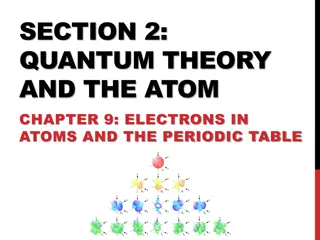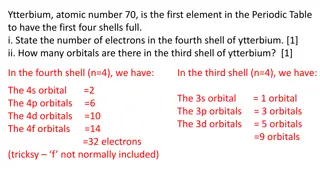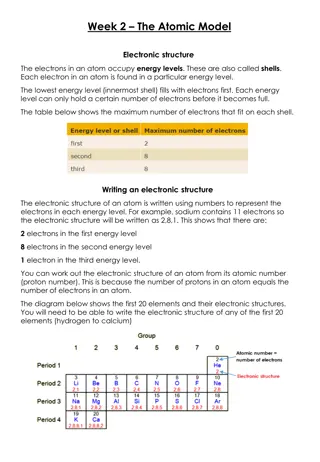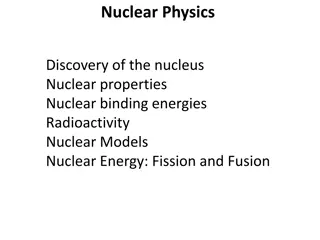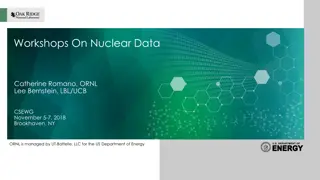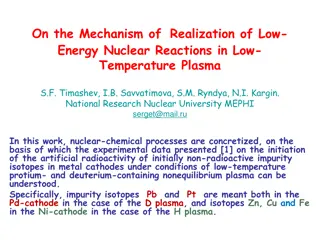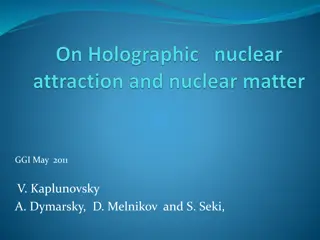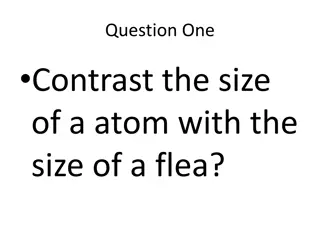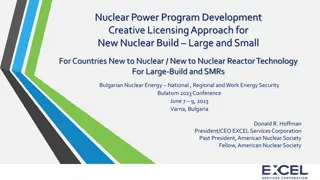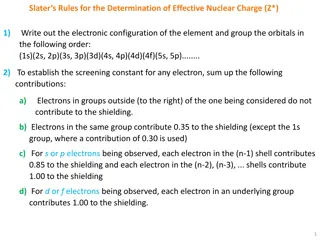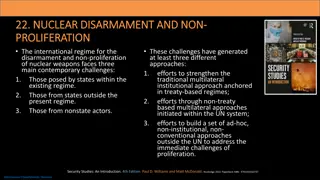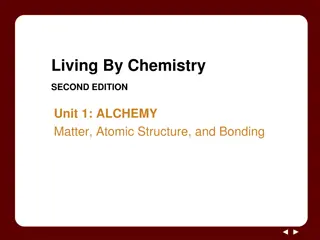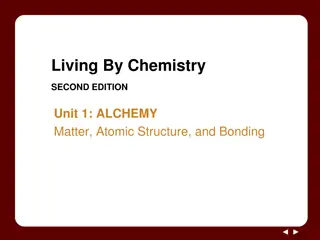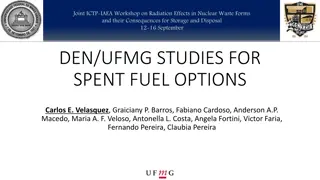Surprising Dimensions of the Atom - Exploring Electron and Nuclear Structures
Delve into the intriguing realm of atomic dimensions, from the vast scale of electrons to the compact nucleus. Explore electron and nuclear densities, modeling scenarios, and historical insights into Rutherford's atomic model. Visualize the metaphorical comparisons that depict the minuscule yet complex nature of atoms.
Download Presentation

Please find below an Image/Link to download the presentation.
The content on the website is provided AS IS for your information and personal use only. It may not be sold, licensed, or shared on other websites without obtaining consent from the author.If you encounter any issues during the download, it is possible that the publisher has removed the file from their server.
You are allowed to download the files provided on this website for personal or commercial use, subject to the condition that they are used lawfully. All files are the property of their respective owners.
The content on the website is provided AS IS for your information and personal use only. It may not be sold, licensed, or shared on other websites without obtaining consent from the author.
E N D
Presentation Transcript
The surprising dimensions of the atom R(electron) ~ 100,000 R(nucleus) m(proton) ~ 2000 m(electron)
More examples of modeling atomic dimensions Basket ball =radius of the nucleus=5 inches = nuclear radius Electron radius =7.89 miles
The metaphor = nuclear radius Electron radius ~ distance from Alfred to Hornell
More examples of modeling atomic dimensions (cont.) Electronic density vs. nuclear density (g/ m3) M(g) Nucleus 10-15 1.67*10 -30 d=M/V ~4*10 +14 V(m3) =4 r3/3 4.2*10 -45 Atom part r(m) Electron cloud 4.2*10 -30 ~2*10 -4 10-10 9.11*10 -34
Modeling electron and nuclear density. d(nucleus)~4*10+14 g/m3 d(electrons)~2*10-4 g/m3 If electron s fill the space=> what weight stuff in it = ?? Recall: M=d*V 3m3 2*10-4 g/m3=6*10-4 g A refrigerator occupies V= 3 m3
Modeling electron and nuclear density. d(nucleus)~4*10+14 g/m3 d(electrons)~2*10-4 g/m3 If nuclei fills the space=> what weight stuff in it = ?? Recall: M=d*V 3m3 4*1014 g/m3=1.2*1015 g A refrigerator occupies V= 3 m3
Electron density=> mass in refrigerator =6*10-4 g in frig The metaphor: 1 grain of salt in frig Nuclear density mass in refrigerator=> =1.2*1015 g in frig = 1.3*109 tons The metaphor: How many of these in frig ..? One Nimitz class carrier = 7*105 tons 1.3*109/7*105~1857 carriers
1912: Rutherford s atomic model rules Electrons (-) out here + Protons (+) and neutrons squeezed in here
1912 : Ernst Rutherford is the `Manand presides over the `Golden Age of Experimental Physics THE ATOM APPEARS CONQUERED vintage Rutherford: All science is either Physics or stamp collecting.
But there are 2 BIG Problems with Rutherford s model 1)Why don t the p+ and e-attract and come together ??? (or why isn t Earth the size of a golf ball?) ???
Rutherford atoms problems (continued) 2)Why doesn t the sun show all colors (e.g. show white light) when telescopes record spectrum? Diffraction grating divides up light colors ??? Why only few really strong lines
AN EVEN BIGGERthird PROBLEM FOR RUTHERFORD S LAB 3) The photoelectric effect problem and the trouble with the theory of light Help!!!!
Language of classical light theory (see also: p 58-60) A C A= amplitude = wavelength (meters) c= speed of light = 3*108 meters/second =f = frequency = # full waves passing a point in a second (cycles/second) nu
Equations of classical light theory (see also: A p 58-60) C f* =c Wave Energy ~ A2 =f = frequency = # full waves passing a point in a second
Units for wave equation frequency * wavelength= speed of light f * =c 1 * meters(m ) =3.0*108 m s seconds(s) Hertz (Hz) Cycles/second (cps)
In-class, on-board exercises with wave equation: f * =c
Photoelectric effect: the textbook version E=Energy of ejected electron from metal See also p. 300-302 of text Threshold frequency for emission varies with metals (f1= 1 for metal 1, f2= 2 for metal 2 etc.)
According to `common sense, which wave capsizes Mickey and the gang ? High amplitude (A) Low frequency (f) Let Mickey and friends be electrons in a metal Low amplitude (A) high frequency (f)
What actually happens in the photoelectric effect experiment High amplitude (A) Low frequency (f) Let Mickey and friends be electrons in metal Low amplitude (A) high frequency (f)
WHAT THE PHOTOELECTRIC EFFECT MEANS: (SEE PAGE 299-304) 1) THE ENERGY, E, OF LIGHT IS NOT CONNECTED TO AMPLITUDE
WHAT THE PHOTOELECTRIC EFFECT MEANS (continued): Planck s constant h in J*s 2) E(J) = h*f = 6.63*10-34 *f(Hz) 1 hz = 1 cycle/second The Planck equation
WHAT THE PHOTOELECTRIC EFFECT MEANS (continued) 3) LIGHT IS NOT A WAVE !!!!
so what is light if not a wave ?????? Einstein s image . LIGHT IS A PHOTON =A MASSLESS BULLET OF ENERGY http://chemistry.umeche.maine.edu/~amar/spring2011/light.gif OL D wave See also Figure 7.5 page 302 NEW Stream of photons
Plancks equation: hf=Ephoton hf hf hf hf Stream of photons Doc s analogy: 1 Photon is like a unit of coiled spring High frequency(high f) high energy tight low frequency (low f) low energy loose
What the `photon idea gives usfirst on board h=6.63*10-34 Joule *s Joules=J E(J)=hf(Hz) Planck s Law Combined with c=f* wave equation => f= c Substitute into E= hc c=3*108 m/s Energy of light is now connected to the color (wavelength) of light in meters(m)
http://blogs.cas.suffolk.edu/jillmartelli/files/2011/10/visible-spectrum1.jpghttp://blogs.cas.suffolk.edu/jillmartelli/files/2011/10/visible-spectrum1.jpg Which is the high energy end of the visible spectrum ? long wavelengths short wavelengths low f High f Units in 10-9 m low E High E
In-class practice on board: Planck s law exercises E(J)= hf =6.63*10-34 J*s *f(Hz) Mole buck opportunities
De Broglies* hypothesis (pp.63-64) http://deskarati.com/wp-content/uploads/2011/06/broglie_big.jpg If light acts `particle- like . then matter can act `wave-like. *Louis-Victor-Pierre-Raymond, 7th duc de Broglie
DeBroglies basic thinking connecting matter to waves: Rest energy of matter* 1) Steal from Einstein: E=mc2 energy of light `wave 2) Steal from Planck: E = hf=hc/ 3) Combine them and simplify: E=mc2=hc/ mc =h/ *Energy you can convert mass m to when it is not moving (at rest), e.g., v=0 source of atomic bombs.
De Broglies Hypothesis (continued) His big idea .assume a similar relationship exists when the mass is moving at a non- zero velocity v. => Replace c with v: mc =h/ mv =h/ Rearrange to define the wavelength of a mass m moving at velocity v = h/mv =>DeBroglie s equation:
Plancks Law explains Photoelectric effect E= hf = h/mv DeBroglie s equation connects matter to a hypothetical How do these fix the problems with Rutherford s atom ?????
Ask him ! (see also pp. 68-72) Niels the kid Bohr at 27 soon after he makes his big theoretical breakthrough.
What the `kid does: Takes a dollop of Old School physics Mixes in New School Planck and DeBroglie equations: E= hf Forces the wavelength to fit a circular orbit around the nucleus: = h/mv see Figure 2.11 pg. 73
From pure theory Bohr derives the Energy, EH, of the electron around Hydrogen and proposes the Bohr model of the atom: n=3 n=2 Eq. 2.1 of text n=1 EH(J)= -2.178*10-18 n2 n=1,2,3 are integers defining circular orbits around positive nucleus
Bohr Model Predictions vs. Experiment Calc theory 434 486 656 ni nf 5 2 4 2 3 2 obs 434 n= 5 1 486 0% error between observed and calculated !!! 4 2 3 656 Observed H line (sun) spectrum (Balmer 3 2 4 2 5 2 Bohr s `explanation of H spectrum : quantum transitions between levels = 434 486 656 nm series)
Bohr Model Predictions vs. Experiment (continued) Theoretical Computed radius of first H orbit: 5.20 nm Experimentally measured ground state radius of H: 5.20 nm 0% error between observed and calculated (again) !!!
Lets confirm that n=5n=2 electron jump predicts =434 nm for H using Bohr model: h=6.63*10-34 J s c=3*108 m/s h*c= 1.989*10-26 J*m
Evolution of the atomic model so far. Thomson Model Bohr Model 1897 1913 http://images.tutorvista.com/content/atoms-and-nuclei/plum-pudding-model.jpeg Philosophical Philosophical Magazine Series 6 Philosophical Magazine44, 295 (1897) Magazine Series 6, 26. 1-25 (1913) 21, 669-688 (1911)
